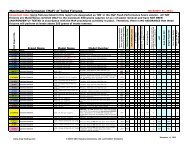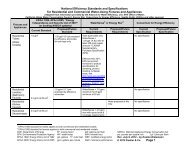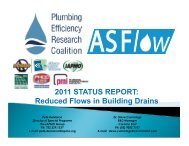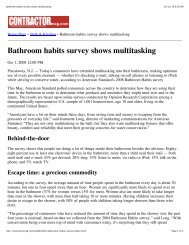Field Study of the AQUS Water Saving Device - (MaP) Testing
Field Study of the AQUS Water Saving Device - (MaP) Testing
Field Study of the AQUS Water Saving Device - (MaP) Testing
- No tags were found...
Create successful ePaper yourself
Turn your PDF publications into a flip-book with our unique Google optimized e-Paper software.
<strong>Field</strong> <strong>Study</strong> <strong>of</strong> <strong>the</strong><strong>AQUS</strong> ® <strong>Water</strong> <strong>Saving</strong> <strong>Device</strong>Report to <strong>the</strong>Metropolitan <strong>Water</strong> District <strong>of</strong> Sou<strong>the</strong>rn Californiain support <strong>of</strong> <strong>the</strong>Innovative Conservation Program GrantRevisedJanuary 2010byKoeller and CompanyYorba Linda, California
Table <strong>of</strong> ContentsIntroduction Page 3Overview <strong>of</strong> <strong>the</strong> <strong>AQUS</strong> System 3History <strong>of</strong> <strong>the</strong> <strong>AQUS</strong> System 3Function <strong>of</strong> <strong>the</strong> <strong>AQUS</strong> System 3<strong>Study</strong> Conclusions 6ICP Grant and Project Background 7Project Start-up – Site Selection 7Installation <strong>of</strong> <strong>AQUS</strong> 9Project <strong>Study</strong> Results 10<strong>Water</strong> Use 10<strong>Water</strong> Meters 10Customer Satisfaction Survey 11Installation Plumber Survey 12O<strong>the</strong>r Important Milestones 13Additional Pilot Projects 13Uniform Plumbing Code and Product Listing 13New <strong>AQUS</strong> Design 13APPENDIX A – Customer Satisfaction Survey Instrument 15APPENDIX B – IAPMO Certificate <strong>of</strong> Product Listing 16
IntroductionOverview <strong>of</strong> <strong>the</strong> <strong>AQUS</strong> ® system<strong>Water</strong>Saver Technologies, LLC’s patented water saving device, The <strong>AQUS</strong> ® , is basedon <strong>the</strong> concept that using fresh water to flush <strong>the</strong> toilet is both unnecessary andwasteful. The <strong>AQUS</strong> ® system captures <strong>the</strong> untreated graywater from <strong>the</strong> bathroomlavatory sink, filters and disinfects it, and uses it to flush a tank-type gravity-fed toilet,<strong>the</strong>reby conserving <strong>the</strong> potable water normally used for flushing.The <strong>AQUS</strong> ® system consists <strong>of</strong> two major components: (1) <strong>the</strong> fill control unit (FCU) and<strong>the</strong> (2) <strong>the</strong> vanity tank. The FCU clips onto <strong>the</strong> back <strong>of</strong> <strong>the</strong> customer’s toilet tank andholds <strong>the</strong> toilet fill valve in <strong>the</strong> “<strong>of</strong>f” position, allowing water from <strong>the</strong> vanity tank locatedunder <strong>the</strong> bathroom sink to fill <strong>the</strong> toilet tank with treated graywater. Periodic (annual)maintenance <strong>of</strong> <strong>the</strong> system is required by employing chlorine tablets and by removing,rinsing and reinstalling <strong>the</strong> filter/screen.History <strong>of</strong> <strong>AQUS</strong> ®<strong>Water</strong>Saver Technologies began development <strong>of</strong> <strong>the</strong> <strong>AQUS</strong> ® in 2004. Throughout thisdesign period and prior to <strong>the</strong> product launch, a number <strong>of</strong> prototypes were built, withwhich beta test installations were conducted in New Mexico, Colorado, and Kentucky.Based upon <strong>the</strong> feedback from beta test users, design modifications were incorporated,new prototypes built and fur<strong>the</strong>r beta testing was conducted.Since <strong>the</strong> initial marketplace introduction <strong>of</strong> <strong>the</strong> <strong>AQUS</strong> ® in 2006, system modificationshave been made to improve installation procedures and system performance. In 2008,<strong>Water</strong>Saver Technologies signed a strategic partnership agreement with Sloan ValveCompany to sell and distribute <strong>the</strong> <strong>AQUS</strong> ® . In <strong>the</strong> fall <strong>of</strong> 2008 and continuing through2009, a complete product review occurred with Sloan Valve Company’s involvement.The goal <strong>of</strong> this review was to investigate ways to reduce <strong>the</strong> system cost, reduceinstallation time and improve performance. The newly redesigned <strong>AQUS</strong> ® will beavailable in 2010. Additional field trials and data ga<strong>the</strong>ring will occur once <strong>the</strong>redesigned <strong>AQUS</strong> ® becomes available.Function <strong>of</strong> <strong>the</strong> <strong>AQUS</strong> ® SystemAs individuals shave, brush <strong>the</strong>ir teeth, apply and remove makeup, take medications,etc. at <strong>the</strong>ir bathroom lavatory sink, <strong>the</strong> wastewater (graywater) from <strong>the</strong> sink flows downthrough <strong>the</strong> standard tubing to <strong>the</strong> vanity tank (#1 – see figure on following page) ra<strong>the</strong>rthan to <strong>the</strong> building drain system. At <strong>the</strong> vanity tank, <strong>the</strong> untreated wastewater nextpasses through a plastic “T”-shaped system component containing a baffle. This bafflesplashes a small amount <strong>of</strong> <strong>the</strong> wastewater into <strong>the</strong> standard p-trap to maintain its primeand control odors. The remainder <strong>of</strong> <strong>the</strong> wastewater flows through a tablet dispensercontaining three chlorine/bromine tablets (#2). As <strong>the</strong> wastewater passes over <strong>the</strong>bottom tablet, chlorine is released sufficient to kill any bacteria that might be in <strong>the</strong>wastewater and leave a 1 ppm or greater chlorine residual in <strong>the</strong> treated water. Thenewly treated wastewater <strong>the</strong>n flows into a 5.5 gallon capacity vanity tank, where itremains until needed for flushing (#4).<strong>Water</strong> Saver Technologies, LLC 3Revised January 2010http://www.watersavertech.com/
How it Works<strong>Water</strong> flows through standard tubingthat is included with <strong>the</strong> system.Tablets in <strong>the</strong> dispenser clean water to controlbacteria and o<strong>the</strong>r contaminants.The screen filters out hair and o<strong>the</strong>r objects.The reservoir holds up to 5 1 ⁄2 gallons <strong>of</strong> water.A 12-volt DC pump moves water through <strong>the</strong> hoseto <strong>the</strong> fill control unit.The fill valve remains undisturbed while <strong>the</strong>system avoids cross connection to fresh wateror interference with backflow prevention.The fill control unit delivers greywaterto <strong>the</strong> toilet tank.
When <strong>the</strong> toilet is flushed and potable water begins to fill <strong>the</strong> toilet, a submersible, 12-volt DC pump (#5) is used to pump <strong>the</strong> treated water to <strong>the</strong> toilet tank. The treated wateris pulled through a coarse screen (#3) that removes long strands <strong>of</strong> hair or largesuspended amounts <strong>of</strong> undissolved material (e.g., toothpaste) from <strong>the</strong> water. Thetreated water is <strong>the</strong>n pumped through a 3/8 th inch flexible tube to <strong>the</strong> rear <strong>of</strong> <strong>the</strong> toilet at<strong>the</strong> base <strong>of</strong> <strong>the</strong> toilet tank. The water enters <strong>the</strong> toilet tank through two hollow, stainlesssteel bolts that connect <strong>the</strong> tank to <strong>the</strong> toilet bowl 1 .The treated water <strong>the</strong>n enters <strong>the</strong> Fill Control Unit (FCU - #7) and spills into <strong>the</strong> toilettank and down <strong>the</strong> overflow tube. As <strong>the</strong> FCU cup is filled, it acts as a counter weightand effectively lifts <strong>the</strong> normal fill valve (#6) and holds it in <strong>the</strong> “<strong>of</strong>f” position. When thisoccurs, potable water is not able to enter <strong>the</strong> toilet tank and <strong>the</strong> <strong>AQUS</strong> ® -treated water isall that is being used to fill <strong>the</strong> toilet tank. The process <strong>of</strong> turning on and turning <strong>of</strong>f <strong>the</strong>fresh water takes only a few seconds.If sufficient treated water is in <strong>the</strong> vanity tank to complete <strong>the</strong> toilet tank fill cycle, <strong>the</strong>n<strong>the</strong> pump automatically turns <strong>of</strong>f. If <strong>the</strong>re is not enough water to complete <strong>the</strong> cycle,<strong>the</strong>n <strong>the</strong> treated water drains from <strong>the</strong> FCU counter-weight cup, releases <strong>the</strong> fill valveand allows potable water to complete <strong>the</strong> fill cycle.1 Current design limits <strong>the</strong> application <strong>of</strong> <strong>the</strong> <strong>AQUS</strong> ® system to two piece tank-type, gravity-fedtoilet fixtures.<strong>Water</strong> Saver Technologies, LLC 5Revised January 2010http://www.watersavertech.com/
<strong>Study</strong> ConclusionsThere are several conclusions drawn from this field study:1. The <strong>AQUS</strong> installations demonstrated fresh water savings, although those savingswere found to be somewhat less than originally anticipated.2. <strong>AQUS</strong> users were satisfied and very complementary <strong>of</strong> <strong>the</strong> system and wouldrecommend it to o<strong>the</strong>rs.3. The continued evolution and development <strong>of</strong> <strong>the</strong> <strong>AQUS</strong> and associated productsis planned and necessary. Such development is expected to result in an increase inwater savings, more applications within <strong>the</strong> home, easier installation, and continuedor expanded consumer acceptance.4. Meter readings taken at <strong>the</strong> seven installations in <strong>the</strong> field study providedevidence <strong>of</strong> limited water savings per year (474 gallons). However, as also noted in<strong>the</strong> report, this may have been due to faulty meters as well as to some <strong>of</strong> <strong>the</strong>installation locations that were initially selected (children’s or secondary baths) and,as such, may experience much lower usage. Based upon American <strong>Water</strong> WorksAssociation data, one would have expected to find a higher savings than wasreported by <strong>the</strong>se meters.<strong>Water</strong>Saver Technologies, in partnership with <strong>the</strong> Sloan Valve Company, is continuing toimprove <strong>the</strong> system through ongoing product development. A new model, available inSpring 2010, will operate within a wider array <strong>of</strong> toilet models, be easier to install, and isexpected to deliver improved performance. The features and expanded applications forthis second generation <strong>AQUS</strong> are listed within <strong>the</strong> report. Once released, <strong>the</strong> newmodel will be deployed in additional pilot projects and <strong>the</strong> resulting data added to thatshown in this report.<strong>Water</strong> Saver Technologies, LLC 6Revised January 2010http://www.watersavertech.com/
ICP Grant and Project Background<strong>Water</strong>Saver Technologies LLC (<strong>Water</strong>Saver) applied for and received a grant from <strong>the</strong>Metropolitan <strong>Water</strong> District <strong>of</strong> Sou<strong>the</strong>rn California (Metropolitan) Innovative ConservationProgram (ICP) to demonstrate <strong>the</strong> benefits and measure water savings associated withits <strong>AQUS</strong> ® system. As noted earlier, <strong>the</strong> system is based upon <strong>the</strong> premise that usingpotable water to flush a toilet is both unnecessary and wasteful.Under <strong>the</strong> terms <strong>of</strong> <strong>the</strong> grant, <strong>Water</strong>Saver planned to contribute 15 <strong>AQUS</strong> ® systems and<strong>the</strong> associated metering and monitoring equipment for <strong>the</strong> primary purposes <strong>of</strong>: (1)evaluating system performance and customer satisfaction; (2) measuring <strong>the</strong> amount <strong>of</strong>water captured, treated, and reused for toilet flushing; and (3) measuring electricityconsumption related to <strong>the</strong> operation <strong>of</strong> <strong>the</strong> system pump.The Metropolitan grant was used to fund: (1) <strong>the</strong> proper installation <strong>of</strong> <strong>the</strong> system; (2)monitoring <strong>of</strong> <strong>the</strong> system for 30+ days; and (3) <strong>the</strong> collection <strong>of</strong> <strong>the</strong> measured data andprepare this report.Installation, maintenance, and monitoring <strong>of</strong> each <strong>AQUS</strong> installation was to be providedby local plumbing companies within <strong>the</strong> service areas <strong>of</strong> <strong>the</strong> selected properties.Following is <strong>the</strong> original cost estimate for <strong>the</strong> Metropolitan grant. The grant provided 50percent <strong>of</strong> <strong>the</strong> MWDSC funding up front, with <strong>the</strong> remainder to be paid upon conclusion<strong>of</strong> <strong>the</strong> project.Project Budget<strong>AQUS</strong> ® system $310 X 15 = $ 4,650Flow Meters $250 X 15 = 3,750Kill-a-Watt Meters $100 X 15 = 1,500Installation $300 X 15 = 4,500Maintenance and Support $300 X 4 = 1,200Data Collection $200 X 15 3,000Data Analysis & Report 6,000Contingency Allowance 2,500Total $ 27,100<strong>Water</strong>Saver committed to contribute <strong>the</strong> 15 <strong>AQUS</strong> ® systems and <strong>the</strong> metering equipmenttoward this project, a total value <strong>of</strong> $9,900. This amount represents approximately 37%<strong>of</strong> <strong>the</strong> overall budget costs and resulted in a total grant funding request <strong>of</strong> $17,200.Project Start-Up – Site SelectionThe ICP grant application was approved for a field trial involving <strong>the</strong> installation <strong>of</strong> 15<strong>AQUS</strong> ® systems. A variety <strong>of</strong> location types were solicited. They included single familyresidences, <strong>of</strong>fices, university dormitories, and hotels. Various individuals assisted inidentifying possible installation sites in Sou<strong>the</strong>rn California. Later, because <strong>of</strong> a ra<strong>the</strong>rlukewarm response to <strong>the</strong> invitations to participate in Sou<strong>the</strong>rn California, <strong>Water</strong>Saverwas given permission to solicit installations in Nor<strong>the</strong>rn California 2 , so long as <strong>the</strong>majority <strong>of</strong> <strong>the</strong> installations were in <strong>the</strong> south.2 Chris Dundon, water conservation manager from <strong>the</strong> Contra Costa <strong>Water</strong> District, assisted inidentifying <strong>the</strong>se installation sites.<strong>Water</strong> Saver Technologies, LLC 7Revised January 2010http://www.watersavertech.com/
Volunteers for <strong>the</strong> system trial were sought from among property owners and managerswilling to participate in a system trial <strong>of</strong> a new water saving product, including bothresidential and business applications. The <strong>AQUS</strong> ® system was <strong>of</strong>fered free-<strong>of</strong>-charge to<strong>the</strong> property owner, with <strong>the</strong> additional proviso that at <strong>the</strong> end <strong>of</strong> <strong>the</strong> trial, <strong>the</strong>y couldhave <strong>the</strong> system removed or, alternatively, keep <strong>the</strong> system for <strong>the</strong>ir own use withoutcost. All equipment and o<strong>the</strong>r hardware, equipment installation (including any requiredmodifications to <strong>the</strong> property needed to accommodate <strong>the</strong> system) and monitoring costswould be borne by <strong>the</strong> installer. Participants were informed that <strong>the</strong> operation <strong>of</strong> <strong>the</strong>system would be monitored and metered for a period <strong>of</strong> no less than 30 days followinginstallation, after which <strong>the</strong> metering devices would be removed.Solicitation <strong>of</strong> participants and identification <strong>of</strong> all sites took several months. Prior to <strong>the</strong>actual installations, however, one participating location removed its name from <strong>the</strong> listand a second was removed from <strong>the</strong> list due to an unforeseen toilet fixtureincompatibility with <strong>the</strong> <strong>AQUS</strong> ® .After final review <strong>of</strong> volunteer sites it was determined that installations would beperformed in a total <strong>of</strong> 11 locations. This was communicated to Tim Schaadt,Metropolitan <strong>Water</strong> District, prior to beginning project installation and he agreed that weshould proceed with <strong>the</strong> locations we had. Unfortunately <strong>the</strong> data collected from four <strong>of</strong><strong>the</strong>se installations was ei<strong>the</strong>r incomplete, contaminated, or not collected.Prior to starting <strong>the</strong> installations, <strong>Water</strong>Saver received a second grant from New YorkUniversity to install two systems in an Alumni Dormitory on campus. It was agreed thatany meter reading data from NYU (while not part <strong>of</strong> <strong>the</strong> 15 <strong>AQUS</strong> ® units in <strong>the</strong> ICP grant)could perhaps be included in <strong>the</strong> project data and that it should be forwarded when itwas received.All interested participants were asked to submit photographs <strong>of</strong> <strong>the</strong>ir bathroom (includingtoilet and vanity) prior to commencing installation. The following is one such photo.<strong>Water</strong> Saver Technologies, LLC 8Revised January 2010http://www.watersavertech.com/
Installation <strong>of</strong> <strong>AQUS</strong>Equipment installation, maintenance, and monitoring at <strong>the</strong> participant locations wasaccomplished by hiring plumbing companies operating in <strong>the</strong> vicinity <strong>of</strong> <strong>the</strong> installationlocations. As a result, three plumbing companies were hired for Sou<strong>the</strong>rn California, dueto <strong>the</strong> large service area involved. One plumbing company was hired to provideassistance in Nor<strong>the</strong>rn California because that company had participated in earlierinstallations <strong>of</strong> <strong>AQUS</strong> ® and was familiar with <strong>the</strong> system.<strong>Water</strong>Saver trained members <strong>of</strong> <strong>the</strong> three (3) plumbing companies in Sou<strong>the</strong>rn Californiaprior to installation. The anticipated 10 sou<strong>the</strong>rn California locations were dividedamong <strong>the</strong>se three companies 3 . The nor<strong>the</strong>rn California installer required no fur<strong>the</strong>rtraining.The following photos show components <strong>of</strong> <strong>the</strong> <strong>AQUS</strong> system and <strong>the</strong> associated flowmeter.The time period for installation, measurement, and evaluation was initially designed tolast a minimum <strong>of</strong> 30 days after each system had been installed. Several systemsremained in place significantly longer, which enhanced <strong>the</strong> reliability <strong>of</strong> collected data.During <strong>the</strong> data ga<strong>the</strong>ring period, it was determined that two installations were equippedwith faulty flow meters, causing <strong>the</strong> <strong>AQUS</strong> ® system to perform improperly. Plumberswere dispatched to <strong>the</strong>se locations, <strong>the</strong> meters were removed, and <strong>the</strong> systems began tooperate properly.3 Two <strong>of</strong> <strong>the</strong> Sou<strong>the</strong>rn California plumbing companies were successful in all but one <strong>of</strong> <strong>the</strong>irassigned locations installed (one location pulled out <strong>of</strong> program). The third plumbing companywas unsuccessful in <strong>the</strong>ir efforts and <strong>the</strong> installations were instead handled by <strong>the</strong> first company.<strong>Water</strong> Saver Technologies, LLC 9Revised January 2010http://www.watersavertech.com/
Project <strong>Study</strong> ResultsAt <strong>the</strong> end <strong>of</strong> <strong>the</strong> data collection period, <strong>the</strong> contracted plumbers made appointmentsand visited each installation in order to collect <strong>the</strong> readings from <strong>the</strong> flow and electricalmeters and to remove those meters. At approximately <strong>the</strong> same time, a CustomerSatisfaction Survey was emailed to each participant with a request to complete <strong>the</strong>survey and return it to <strong>Water</strong>Saver.<strong>Water</strong> UseAs noted above, each installation was equipped with a totalizing meter to record <strong>the</strong>amount <strong>of</strong> water delivered to <strong>the</strong> <strong>AQUS</strong> ® unit, processed (treated), and pumped to <strong>the</strong>nearby toilet tank. The water, <strong>the</strong>n, was an “<strong>of</strong>fset” for what would o<strong>the</strong>rwise be potablewater filling that tank. As such, <strong>the</strong> total amount <strong>of</strong> water delivered from <strong>the</strong> <strong>AQUS</strong> ® wasan accurate measure <strong>of</strong> <strong>the</strong> total reduction in potable water use.Table 1 shows <strong>the</strong> meter measurements and <strong>the</strong> water use reductions achieved with <strong>the</strong>seven remaining installations providing valid water usage data. Those seveninstallations yielded water use reductions averaging approximately 1.3 gallons persystem per day, about 474 gallons annually for a toilet fixture used on a daily basis by anaverage <strong>of</strong> 2.57 persons.<strong>Water</strong> MetersThe project used an in-line flow meter placed downstream from <strong>the</strong> pump, between <strong>the</strong>pump and <strong>the</strong> toilet tank. The meter was advertised to operate properly at low watervolumes and with intermittent flows. Prior to beginning <strong>the</strong> installations, one meter waspurchased and tested for accuracy and met <strong>the</strong> criteria. However, during <strong>the</strong> 30 daystest period, two <strong>of</strong> <strong>the</strong> <strong>AQUS</strong> ® installations encountered significant meter problems. Inone case, <strong>the</strong> system encountered problems because <strong>the</strong> impeller in <strong>the</strong> flow meter wasjamming and severely restricted <strong>the</strong> water flow from <strong>the</strong> <strong>AQUS</strong> ® holding tank to <strong>the</strong> toilettank. In <strong>the</strong> second case, a unit installed at New York University was found to have <strong>the</strong>same problem. Plumbers were dispatched to <strong>the</strong>se two locations, where <strong>the</strong>y removed<strong>the</strong> meters 4 , and, as a result, <strong>the</strong> systems began to function properly.Flow meter readings generally ranged from 20 to 200 gallons over periods <strong>of</strong> about 30 to90 days. Readings from three installations were discarded due to suspect data orindependent actions by <strong>the</strong> participant that were deemed to be non-representative <strong>of</strong> atypical household 5 . Additionally, some meter readings may have been lower due to <strong>the</strong><strong>AQUS</strong> ® being installed in a children’s or a secondary bath. Fur<strong>the</strong>rmore, it should alsobe noted that all flow meter readings could be considered suspect and <strong>the</strong> data could beunderreported due to <strong>the</strong> previously described experience with impellers inside <strong>the</strong>meters not turning properly 6 .4 In <strong>the</strong> first instance, <strong>the</strong> water use data (savings) was suspected to be underreported, althoughit was used in <strong>the</strong> project analysis. In <strong>the</strong> second case, <strong>the</strong> data from New York University wasdiscarded and not used in <strong>the</strong> analysis due to significant uncertainty as to its accuracy.5 One participant admitted to collecting graywater from <strong>the</strong>ir shower in a bucket and <strong>the</strong>n dumpingthat water into <strong>the</strong> lavatory sink to be treated by <strong>the</strong> <strong>AQUS</strong> system. This clearly increased <strong>the</strong>throughput <strong>of</strong> <strong>the</strong> <strong>AQUS</strong> ® system beyond what would normally be expected in <strong>the</strong> typicalhousehold.6 A new, more suitable meter will be selected for any future pilot programs.<strong>Water</strong> Saver Technologies, LLC 10Revised January 2010http://www.watersavertech.com/
Table 1. Flow Meter Readings and <strong>Water</strong> <strong>Saving</strong>sMeterinstallMeterremoveDays <strong>of</strong>Avg. dailywater usage(savings)per toiletAvg dailywaterusage(savings)per personName date Day no. date Day no. Install (gallons) toilet (gal) (gal) kwhTS 4/7/09 97 5/6/09 126 29 60 4 2.07 0.5172 11.71BC 4/17/19 107 6/9/09 160 53 100 2 1.89 0.9434 12.2ES 4/22/09 112 6/11/09 162 50 200 4 4.00 1.0000 12.47JC 4/9/09 99 7/1/09 182 83 40 2 0.48 0.2410 6.2MB 4/6/09 96 7/2/09 183 87 20 2 0.23 0.1149 1.17AW 4/8/09 98 7/8/09 189 91 40 2 0.44 0.2198JS 5/6/09 126 7/15/09 196 70 140 2 2.00 1.0000Total or averageMeterReadNo.personsusing463 600 2.57 1.296 0.5766ElectricityconsumptioninThe figures below display <strong>the</strong> Kill-A-Watt meter and <strong>the</strong> flow meter used in <strong>the</strong> project.Customer Satisfaction SurveyAppendix A displays an example <strong>of</strong> a completed Customer Satisfaction Survey.The Customer Satisfaction Survey requested feedback on a number <strong>of</strong> important topics,including <strong>the</strong> appearance <strong>of</strong> <strong>the</strong> water, use <strong>of</strong> space within <strong>the</strong> vanity housing <strong>the</strong> <strong>AQUS</strong> ®<strong>Water</strong> Saver Technologies, LLC 11Revised January 2010http://www.watersavertech.com/
system, and overall satisfaction with performance. The following is a synopsis anddiscussion <strong>of</strong> each topic.<strong>Water</strong> Appearance - The survey requested feedback on <strong>the</strong> appearance andacceptability <strong>of</strong> <strong>the</strong> treated water in <strong>the</strong> toilet bowl. All <strong>of</strong> <strong>the</strong> installations stated that <strong>the</strong>appearance <strong>of</strong> <strong>the</strong> water in <strong>the</strong> toilet bowl was acceptable (100 percent indicating “VeryClean” or “Fairly Clean”).Odors - Respondents were asked to provide feedback on whe<strong>the</strong>r <strong>the</strong>y noticed anyodors from <strong>the</strong> <strong>AQUS</strong> ® system. Eighty percent <strong>of</strong> <strong>the</strong> installations stated that <strong>the</strong>re wasno noticeable odor. Two installations indicated that <strong>the</strong>y experienced a slight chlorineodor at times.Pump Noise - The <strong>AQUS</strong> ® uses a small 12-volt DC pump to deliver <strong>the</strong> treated waterfrom <strong>the</strong> holding tank to <strong>the</strong> toilet tank . Survey respondents were asked whe<strong>the</strong>r <strong>the</strong>yhad any issues with pump noise. Sixty percent <strong>of</strong> <strong>the</strong> installations stated that <strong>the</strong> pumpsound was “somewhat noticeable”, while <strong>the</strong> remaining 40 percent stated “notnoticeable”.Use <strong>of</strong> Vanity Space - The <strong>AQUS</strong> ® holding tank, located within <strong>the</strong> bathroom vanity,holds 5.5 gallons <strong>of</strong> water and can take up a significant amount <strong>of</strong> space, displacingspace normally used by <strong>the</strong> homeowner for storing bathroom cleaning supplies, towels,etc. The survey asked whe<strong>the</strong>r this use <strong>of</strong> <strong>the</strong> vanity space was “acceptable”. Seventyfive(75) percent <strong>of</strong> <strong>the</strong> participants indicated that <strong>the</strong> use <strong>of</strong> <strong>the</strong> vanity space by <strong>the</strong> tankwas “Acceptable” or “Very Acceptable”.<strong>AQUS</strong> ® Function - All but one <strong>of</strong> <strong>the</strong> respondents stated that <strong>the</strong>y had “few” or “noproblems” with <strong>the</strong> system. The one exception was a participant whose pump andswitch mechanism had intermittent failures and had to be readjusted twice. The issuewas determined to be physical limitations attributable to <strong>the</strong> style and design <strong>of</strong> <strong>the</strong> toilettank.Save <strong>Water</strong> and Overall Satisfaction - Almost 70 percent <strong>of</strong> <strong>the</strong> respondents believedthat <strong>the</strong>y saved water using <strong>the</strong> <strong>AQUS</strong> ® and over 90 percent stated that <strong>the</strong>y were“somewhat satisfied” or “very satisfied” with <strong>the</strong> system.Recommend to O<strong>the</strong>rs - The respondents were asked whe<strong>the</strong>r <strong>the</strong>y would recommend<strong>the</strong> <strong>AQUS</strong> to o<strong>the</strong>rs. All but one <strong>of</strong> <strong>the</strong> respondents stated that “yes”, “definitely yes”, or“perhaps” <strong>the</strong>y would recommend <strong>the</strong> <strong>AQUS</strong> ® .Installation Plumber Survey<strong>Water</strong>Saver also solicited comments from <strong>the</strong> plumber-installers, including <strong>the</strong> amount <strong>of</strong>time required to install each component <strong>of</strong> <strong>the</strong> system and any comments that might help toimprove <strong>the</strong> installation process.Vanity Tank - The installation <strong>of</strong> <strong>the</strong> <strong>AQUS</strong> ® tank within <strong>the</strong> vanity was generallystraightforward and required approximately one hour to remove existing plumbing drainlines and connect <strong>the</strong> <strong>AQUS</strong> ® . However, in two instances where <strong>the</strong> vanity cabinet floorwas too high for system, a hole had to be cut to recess <strong>the</strong> tank below <strong>the</strong> kick plate.This dramatically increased <strong>the</strong> installation time.<strong>Water</strong> Saver Technologies, LLC 12Revised January 2010http://www.watersavertech.com/
Toilet Tank - The installation process requires that <strong>the</strong> toilet tank be disassembled from<strong>the</strong> bowl 7 . As such, <strong>the</strong> installation <strong>of</strong> <strong>AQUS</strong> ® components was <strong>the</strong> most timeconsumingpart <strong>of</strong> <strong>the</strong> process. Rusted tank bolts and adjusting <strong>the</strong> <strong>AQUS</strong> ® to workwithin <strong>the</strong> specific toilet 8 required 2-3 hours to accomplish 9 .O<strong>the</strong>r Important MilestonesAdditional pilot projects - <strong>Water</strong>Saver, along with Sloan Valve Co., have planned severaladditional pilot projects beginning in 2010. Many <strong>of</strong> <strong>the</strong>se projects will include more reliableflow meters and more comprehensive customer satisfaction surveys, <strong>the</strong> data from whichwill be incorporated in addenda to this report. The additional data and customer andinstaller feedback will aid product development.Uniform Plumbing Code (UPC) and Product Listing - At <strong>the</strong> time that <strong>the</strong> ICP grantapplication was submitted, <strong>the</strong> <strong>AQUS</strong> ® had received a Classified Product Listing fromIAPMO 10 . During <strong>the</strong> time this project was being conducted, IAPMO issued a full ProductListing for <strong>the</strong> <strong>AQUS</strong> ® . That Certificate <strong>of</strong> Listing is included as Appendix B.New <strong>AQUS</strong> Design - <strong>Water</strong>Saver Technologies, LLC formed a strategic partnership withSloan Valve Company 11 to sell and distribute <strong>the</strong> Sloan <strong>AQUS</strong> ® throughout <strong>the</strong> UnitedStates. A part <strong>of</strong> that agreement was to examine <strong>the</strong> existing <strong>AQUS</strong> ® for productimprovements (e.g.. broadening <strong>the</strong> compatibility <strong>of</strong> <strong>AQUS</strong> ® to more toilet models), reducinginstallation time, and reducing product costs.The following is a comparison between <strong>the</strong> current <strong>AQUS</strong> ® and <strong>the</strong> new <strong>AQUS</strong> ® proposedfor 2010.Current System• Toilet Tank Requirementso Fluidmaster type fill valveo Two-piece, gravity-fed toileto Minimum 16” toilet tank width• Installationo Requires toilet tank components (fill valve and FCU) to work toge<strong>the</strong>r,which requires fine tuned adjustments and lengthy installation times.o Requires removal <strong>of</strong> toilet tank bolts• Institutional appearance7 Only two-piece gravity-fed toilet fixtures may currently be fitted with <strong>AQUS</strong> ® components. A listing <strong>of</strong><strong>the</strong> toilet fixture models compatible with <strong>the</strong> current <strong>AQUS</strong> ® design may be found at this website:http://www.sloanvalve.com/index_<strong>AQUS</strong>_Greywater_System_ENU_HTML.htm8 The physical dimensions and configurations <strong>of</strong> toilet tanks differ significantly from model to model.Therefore, physical compatibility <strong>of</strong> <strong>AQUS</strong> ® components with specific toilet tank designs can becomean issue for installers.9 This time will be dramatically reduced when <strong>the</strong> next generation <strong>of</strong> <strong>the</strong> <strong>AQUS</strong> ® design is introducedin 2010.10 International Association <strong>of</strong> Plumbing and Mechanical Officials, an accredited product certifyingbody.11 http://www.sloanvalve.com/ andhttp://www.sloanvalve.com/index_<strong>AQUS</strong>_Greywater_System_ENU_HTML.htm<strong>Water</strong> Saver Technologies, LLC 13Revised January 2010http://www.watersavertech.com/
2010 Design <strong>AQUS</strong> ®• Application to more toilet modelso Dual Flusho Side fill toilets (European style)o Multiple fill valve designs! Fill valves used in side fill toilets! Pilot type fill valve! Ballcock type fill valveo One-piece Toiletso No tank size limitation• Easier Installationo No bolts to replaceo No disassembly and draining <strong>of</strong> <strong>the</strong> toileto No FCU to install in Toilet tanko Reduced installation time by approximately 50 percent• <strong>AQUS</strong> ® appearance and customer acceptabilityo Coloro Square Shape 15” Square – smoo<strong>the</strong>r edgeso Tank holds same volume <strong>of</strong> water<strong>Water</strong> Saver Technologies, LLC 14Revised January 2010http://www.watersavertech.com/
APPENDIX A<strong>AQUS</strong> Customer Satisfaction SurveyThank you for participating in <strong>the</strong> <strong>AQUS</strong> ® Greywater Pilot Project funded by <strong>the</strong> Metropolitan <strong>Water</strong> District. The goal <strong>of</strong> this project is todemonstrate that <strong>the</strong> <strong>AQUS</strong> ® is a viable product and can be included in <strong>the</strong>ir list <strong>of</strong> products that conserve water. We would like you tocomplete <strong>the</strong> survey below to help us better understand customer reaction to <strong>the</strong> <strong>AQUS</strong>.Installation Date: April 1, 2009Installation Location & Name:Jill and Richard CrueyAddress: 27 Gibson LaneCity: ClaytonState: CA Zip: 94517Tele: 925-207-8992Please circle <strong>the</strong> type <strong>of</strong> bathroom in which <strong>the</strong> device was installed:Hall BathHow many people typically use this bathroom?2How many times per day do you think this toilet is flushed?6The water in <strong>the</strong> bowl appears:1 2 3 4 5Fairly CleanComments:Odor from <strong>the</strong> water in <strong>the</strong> toilet bowl is:1 2 3Somewhat noticeableComments:The sound from <strong>the</strong> <strong>AQUS</strong> ® water pump is:1 2 3Not noticeableComments:The <strong>AQUS</strong> ® Tank was installed in <strong>the</strong> bathroom vanity cabinet. The use <strong>of</strong> this space is:1 2 3 4AcceptableComments:The <strong>AQUS</strong> ® has functioned with:1 2 3No ProblemsIf you experienced problems with <strong>the</strong> function, please list <strong>the</strong> issues in <strong>the</strong> space below:Do you think you saved water by using <strong>the</strong> <strong>AQUS</strong> ® in your home?1 2 3 4YesComments: Yes, probably. We know that <strong>the</strong> system is working and with <strong>the</strong> toilet using 3- 4 gallons to flush, we are saving up to 24gallons per day.Overall satisfaction with <strong>the</strong> <strong>AQUS</strong> ®1 2 3 3Very SatisfiedComments:I would recommend <strong>the</strong> <strong>AQUS</strong> ® to o<strong>the</strong>rs1 2 3Definitely Yes<strong>Water</strong> Saver Technologies, LLC 15Revised January 2010http://www.watersavertech.com/
APPENDIX BCERTIFICATE OF PRODUCT LISTING BY IAPMO<strong>Water</strong> Saver Technologies, LLC 16Revised January 2010http://www.watersavertech.com/








